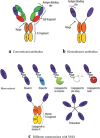Perspective on therapeutic and diagnostic potential of camel nanobodies for coronavirus disease-19 (COVID-19)
- PMID: 33500874
- PMCID: PMC7820838
- DOI: 10.1007/s13205-021-02647-5
Perspective on therapeutic and diagnostic potential of camel nanobodies for coronavirus disease-19 (COVID-19)
Abstract
In this paper, we focus on the camelid nanobodies as a revolutionary therapy that can guide efforts to discover new drugs for Coronavirus disease (COVID-19). The small size property makes nanobodies capable of penetrating efficiently into tissues and recognizing cryptic antigens. Strong antigen affinity and stability in the gastrointestinal tract allow them to be used via oral administration. In fact, the use of nanobodies as inhalant can be directly delivered to the target organ, conferring high pulmonary drug concentrations and low systemic drug concentrations and minimal systemic side effects. For that, nanobodies are referred as a class of next-generation antibodies. Nanobodies permit the construction of multivalent formats that may achieve ultra-high neutralization potency and then may prevent mutational escape and can neutralize a wide range of SARS-CoV-2 variants. Due to their distinctive characteristics, nanobodies can be of great use in the development of promising treatment or preventive strategies against SARS-CoV-2 infection. In this review, the state-of-the-art of camel nanobodies design strategies against the virus including SARS-CoV-2 are critically summarized. The application of general nanotechnology was also discussed to mitigate and control emerging SARS-CoV-2 infection.
Keywords: Antibodies engineering; Coronavirus disease (COVID-19); Heavy chain antibodies; Pandemic; Single-domain antibody.
© King Abdulaziz City for Science and Technology 2021.
Conflict of interest statement
Conflict of interestThe authors declare that they have no conflict of interest in the publication.
Figures



References
-
- Ashour J, Schmidt FI, Hanke L, Cragnolini J, Cavallari M, Altenburg A, et al. Intracellular expression of camelid single-domain antibodies specific for influenza virus nucleoprotein uncovers distinct features of its nuclear localization. J Virol. 2015;89:2792–2800. doi: 10.1128/JVI.02693-14. - DOI - PMC - PubMed
Publication types
LinkOut - more resources
Full Text Sources
Other Literature Sources
Miscellaneous

